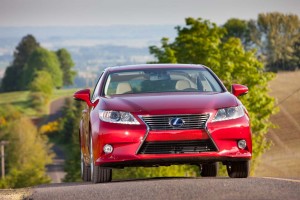Lexus is looking to an unprecedented array of new products, along with a revitalized production system to help it recover from last year’s sharp sales slide.
Long the U.S. luxury sales leader, Lexus suffered a sharp decline in 2011 under an assault by key German rivals compounded by the production cuts that followed Japan’s devastating March earthquake and tsunami. The Toyota subsidiary wound up in third place for the year, behind both BMW and Mercedes-Benz.
But barring the collapse of the U.S. market, Lexus officials are anticipating a sales increase of as much as 25% for all of 2012, along with a several point increase in market share. However, it doesn’t appear the brand is in the running to regain its segment leadership.
“I don’t believe we’re going to put up the numbers,” said Tim Morrison, vice president of sales for Lexus, in part because “the Germans have much more extensive product lines.”
Indeed, BMW, Mercedes and Audi have been flooding dealers with all manner of new models in recent years and Morrison cautioned that, “I don’t think you’re going to see us match that.”
Nonetheless, Lexus isn’t sitting on the sidelines. All told, the maker plans to launch nine new or significantly updated products this year alone – a figure that jumps to an even dozen if you include F-Sport performance versions of three other models including the RX crossover.
Morrison and other Lexus executives were in Detroit to show off one of those new offerings, the ES sedan. For 2013 it gets a new chassis that grows an inch overall, an all-new hybrid powertrain, and a new look strongly influenced by the 2012 Lexus GS, with its distinctive “spindle grille” that will become the new face for the Japanese brand.
The new ES arrives a little too late in the year – sales launching in the U.S. in August – to have a major impact on 2012 volume but it will move Lexus in the right direction, stressed Morrison. The outgoing sedan could reliably be expected to generate about 3,500 sales a month but the new Lexus ES is projected to boost that to 5,000 – about a quarter of that higher volume coming from the new new ES 300h hybrid.
The maker is also hoping to draw in younger buyers with the 2013 ES, something that has proven to be a serious challenge for the Lexus brand, as a whole, which has had a problem reaching beyond aging Baby Boomers. If the new ES succeeds it could see an average buyer age of around 50, almost a decade younger than the current model.
The addition of the new ES, along with updates of models including the GS and critical RX, will clearly help Lexus gain momentum. But the primary factor in its recovery will be the fact that all its plants are now operating at full speed again.
In the wake of last year’s natural disaster, Toyota lost 100s of thousands of units of production among all its brands, some model lines only reaching full capacity again by the end of 2011. The situation was compounded by flooding in Thailand, last autumn, which caused further production delays.
Add competitive pressures and Lexus saw sales plunge to just 197,234, down from 228,129 in 2010.
Toyota is bullish about the U.S. automotive recovery, predicting the total new vehicle market will rise 1.5 million units to 14.4 million, the luxury market posting an especially strong resurgence.
For the first five months of 2012, Lexus sales are up 20%, year-over-year. The maker expects that to reach 25%, sales for the full year projected to reach 250,000.
Demand for hybrids has clearly helped Lexus which offers more gas-electric models than any of its competitors. The spring surge in U.S. fuel prices only fed consumer desire for hybrids. But with fuel prices slipping in recent weeks, Morrison conceded that demand for the dedicated hybrid model, the CT200h has been slipping.
On the other hand, the hybrid version of the maker’s crossover, the RX450, “doesn’t seem to react to the price of gas.”
As TheDetroitBureau.com reported this week, Honda plans to curb exports of Japanese-made products to the U.S. market due to the lopsided dollar/yen exchange rate. (Click Here for that story.)
As for Lexus, Morrison said there are no plans to cut Lexus exports to the States. On the other hand, there is an ongoing “conversation” about shifting more Lexus production to the U.S. — which accounts for about half the brand’s global volume – “to blunt the effect of currency exchange rates.”
But, so far, there are no firm plans in place to move models like the ES to one of Toyota’s North American assembly plants.
Joe Szczesny contributed to this report.

